TL;DR: Wrestling games have been great in the past, but recent titles in the genre, namely from the WWE 2K series, have been less than stellar. Some critics have posited that wrestling games should break kayfabe and reflect the more realistic aspects of the business, but I think depicting wrestling as “a real struggle for victory” can still be done well in a videogame. It’s still real to me, damn it!
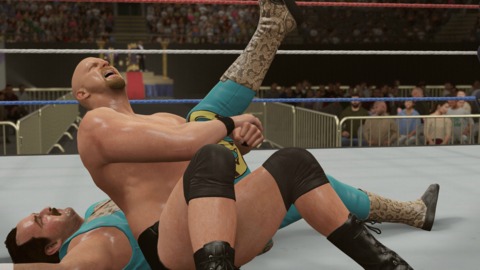
The upcoming release of WWE 2K16 has got me thinking a lot about the state of the WWE 2K series and the general quality and design of wrestling video games as a whole. Promising a larger roster and tons of improvements to the base mechanics, 2K16 aims to be a much better product than last year’s disastrous, stripped down iteration. But is it enough to make an exceptional wrestling game? 2K15 left a bad taste in many player’s mouths, and I have to imagine that the annualized release schedule of wrestling games for at least the past decade and a half has led to some fatigue among fans.
Out of the backlash against 2K15 in particular, it seems there was an influx of opinions stating that wrestling games should stop trying to be awkward, grapple-based fighting games and just “break kayfabe.” This Vice article posits that WWE 2K16 should focus more on the performance art and business management aspects of “sports entertainment” that lurk behind the kayfabe veil, and Giant Bomb’s own Jeff Gerstmann has suggested in Quick Looks that the mechanics of wrestling games should instead involve working together with your opponent to put on a show. We’re in the Reality Era after all, so maybe developers should stop perpetuating the traditional in-ring feud and create a more realistic depiction of wrestling.
Despite what the title of this blog may have you believe, I think breaking kayfabe in wrestling games could be a great idea. I would love to see a developer take a stab at designing wrestling mechanics as a pseudo-cooperative dance. Considering most wrestling moves are really a 50/50 effort between both performers for the purpose of captivating an audience, I think there’s a lot of potential in a wrestling game that puts the challenge in harmonious performance and telling a good in-ring story, rather than just defeating your opponent. I’d also like to see a wrestling game that focuses on the management and drama side of things, forcing players to deal with monetary issues, questionable booking decisions from writers, relationships with other talent and higher-ups in the company, and maybe even drug problems.
With all that said, I still believe there’s some steam left in the traditional wrestling game machine. I still really like the idea of depicting wrestling as a fight for honor and glory through a complex, intricate style of combat, even if recent attempts at this have been unsuccessful.
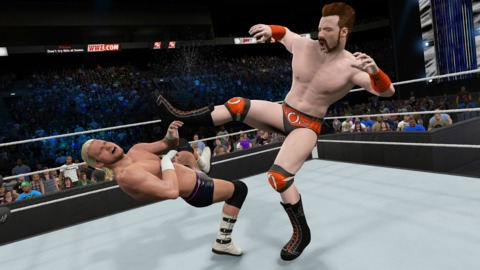
This sentiment mostly comes from my nostalgia for the good ol’ days of wrestling. I discovered WWF around late 99 or early 2000 and absolutely fell in love with it over the next couple of years. I was so infatuated with the chaos unfolding on the screen because, as stupid as it sounds, I believed it was all real. I really thought The Rock and Stone Cold hated each other with a passion, I really thought Kane’s mask hid a scarified face that was burned by The Undertaker, and I really thought the Dudley Boys had a freaky fetish for tables. Likewise, I loved reenacting all these storylines and rivalries in old wrestling games like WWF Wrestlemania 2000 and No Mercy. I could take control of my favorite wrestlers and get involved in their theatrical struggles, and it was fun because I didn’t realize it was just theatrics.
I started gaining an interest in the WWE again last year, but my affection for the show is nowhere near as massive as it was almost 15 years ago, and I would partially attribute this to my awareness of the predetermined nature of wrestling and the other business realities behind the scenes. Don’t get me wrong, I still have a ton of respect for the performance art of wrestling, but I loved it more when I was a stupid kid and I didn’t know “kayfabe” was even a thing. That’s where wrestling games come into play. They can still fulfill those childhood fantasies and let players act out heated rivalries and goofy storylines. I want a wrestling game in which I win a match by being the better wrestler; I don’t want my victory to be determined by a booker or higher-ups in the company who want to give me a push.
I would argue that the problem with wrestling games isn’t their stubborn commitment to maintaining kayfabe. Rather, the problem lies in the basic mechanics, which, in my opinion, have never perfectly nailed the feel and tension of wrestling. Maybe the problem with most wrestling games (at least the ones I’ve played) is that they’re built on the foundations of traditional fighting games, which doesn’t translate well to a wrestling setting. This is particularly evident when complex moves and submissions can be performed by relatively simple button combinations. As a result, much of the combat seems to involve watching lengthy canned animations of suplexes and powerbombs take place, and it never feels like you have direct 1-to-1 control over your wrestler and his/her moves.
Compared to 2D fighting games, which mainly focus on rapid punches and kicks, the scope of professional wrestling should be much larger, with tons of crazy moves, submission holds, and match types that can happen. However, most wrestling games have had to make some compromises in an attempt to account for all those possibilities. Since it's pretty difficult to map the versatility of an entire wrestling moveset on even a modern controller, wrestling games have heavily relied on context-sensitive timing and positioning, and they've done this to varying degrees of success.
I’ll admit that it’s not entirely fair to make blanket statements about the quality of all wrestling games. Maybe it would be more productive to look at a few highly regarded games in the genre and pinpoint their specific strengths and weaknesses.
WWF No Mercy
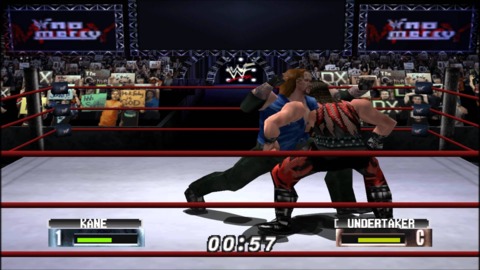
If any online discussion about this game is to be believed, it’s the greatest wrestling game ever made. That, or it simply evokes the most nostalgia. Either way, it’s my personal favorite, and I believe its reverence has been well earned. AKI Corporation has consistently knocked it out of the park with their N64 wrestling games, and No Mercy is the peak of their signature design. The game boasts plenty of new features including an expanded character creator, a broader set of irish whip and double-team moves, and a bunch of backstage areas to hold Hardcore matches, but No Mercy also sticks to tradition with its intuitive grapple controls and minimalist “Spirit meter” mechanic. Those basic design elements, which have served as the foundations of AKI’s wrestling titles, are nearly perfect for setting a pace and momentum that is rarely ever matched by other wrestling games. Despite No Mercy’s technical limitations, its matches are tense and move at just the right tempo, eliciting an energy similar to a “real” wrestling bout, a “real” struggle for victory.
However, No Mercy does have its fair share of issues. For instance, the aforementioned grapple-based controls represent an unfortunate example of compromises in wrestling games. It is indeed a simple and intuitive control system, but it’s relied on too heavily, leading to unnatural transitions to other moves. It feels particularly weird performing a Sweet Chin Music or a Stone Cold Stunner directly from a grapple.
Those minor control issues are just nitpicks in comparison to No Mercy’s presentation problems. I’ll admit the game does achieve a decent amount of authenticity within the N64’s limited horsepower, and Vince McMahon’s version of the People’s Elbow is eerily accurate, but that example is just a diamond in the rough full of stilted animations and entrances with terrible visual/audio quality. A large part of wrestling, especially in the WWE, is the presentation and the pageantry, and the AKI games often miss the mark in this regard.
Also, this game appears to have some serious balance issues. According to this No Mercy tier list on the Shoryuken forums, X-Pac is considered god tier. What.
WWE SmackDown! Here Comes the Pain
What No Mercy lacks in production value, Here Comes the Pain makes up for it and then some. Yuke’s made the most content-packed wrestling game of recent memory and went above and beyond to make it true to the WWE product with an incredible attention to detail: Most of the wrestlers have unique animations accurate to their on-screen personas; tag teams have their own special entrances and poses; interactions with the referee (especially in tag matches) can have an impact on the match; Cage, Hell in a Cell, and Elimination Chamber matches are present and accounted for (among myriad other match types); pretty much any imaginable combination of wrestlers can participate in these match types, including regular and tornado tag teams; and the list goes on. All these little things, combined with numerous create-a-modes that let you make whatever the hell you want, add up to make an incredible value package for WWE fans.
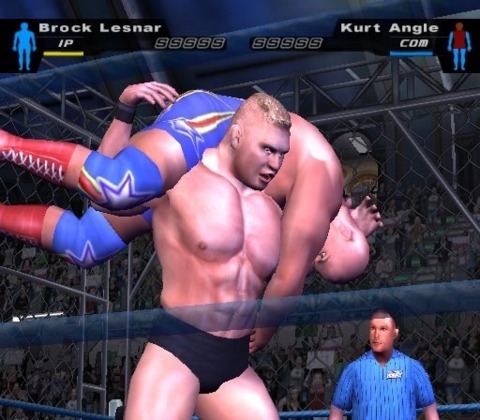
The gameplay isn’t bad either. HCTP makes some substantial improvements over its predecessors, all of which make for a deep and varied wrestling experience. Players have at their disposal a two-step grapple system to perform a variety of standing moves, a ton of other positions (tree of woe, teetering on the edge of the Cell, etc.) in which unique moves can be dished out, and a body indicator on the HUD that shows players how close they are to breaking an opponent’s limbs. In short, this game’s complexity makes it one of the few in the wrestling genre that avoids making too many compromises.
However, the complexity of HCTP may not sit well with newer players. Once again, the grapple system is the culprit of the issue, this time because of its confusing button-mapping. In my experience, it was not immediately clear which d-pad/circle button combination performed, for instance, a weak grapple versus a strong grapple. To add to the confusion, the d-pad controls for moves and strikes don’t change according to which way you’re facing your opponent, and I imagine this would be particularly weird for players who are used to traditional fighting games. A simpler No Mercy-esque system (in which you tap the button for weak attack, hold the button for strong attack, and d-pad combinations perform more intuitive move variations) would be preferred.
The AI opponents don't really give you much time to learn the ropes either. Oftentimes I find myself getting pummeled by my opponent with no way of escaping. And this is on the easiest difficulty and fairly early in the match. I realize this sort of momentary one-sided combat regularly happens in real matches, and this might just be me sucking at the game, but it’s not fun being on the receiving end of that beating. I feel like I should have more control in those scenarios.
Quite simply, HCTP’s complexity isn’t always conducive to fluid wrestling. Many of my matches involve downright sloppy moments chock full of nonsense button-mashing (a tactic that seems to be encouraged, as that’s how you’re supposed to escape pinfalls and submissions).
Fire Pro Wrestling
Another big favorite among wrestling game fans. I'll admit I actually have no prior experience with the FPW series, so I briefly played Fire Pro Wrestling Returns as part of my research for this blog and I was immediately overwhelmed with the smorgasbord of options available on every menu in the game. The game features plenty of traditional, hardcore, and MMA match types, tons of variations and settings within those match types, and plenty Create-a-Modes that let you create custom wrestlers, referees, rings, and title belts, among other things. There’s enough here to make for a robust booking simulator.
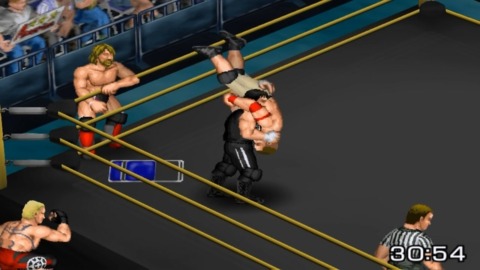
As for the gameplay, the controls are simple while still providing versatile moveset that really allows skilled players to dictate the pace of a match. I know I've used the word "intuitive" a lot in this blog, but I think FPW really nails this concept. Basically, the game has separate buttons dedicated to weak, medium, and strong strikes/moves, and you initiate a grapple by simply walking into an opponent. Can’t get much simpler than that. On the other hand, the specific timing required to perform grapple moves and avoid reversals adds a surprising amount of depth to the combat. I was also intrigued to find that FPW Returns has a “breathe” button, which you will want to use at appropriate times to catch your breath and avoid fatigue. Both the grapple system and breath mechanic add a layer of strategy and timing I’ve never seen in a wrestling game. FPW manages to do a whole lot more within its sprite-based 2.5D graphics than I expected.
However, the main thing that is hindering my enjoyment of this strategic depth is the simple fact that I suck at this game. I know, that’s not a legitimate criticism, as I understand this game has a steep learning curve. I have been reading some guides and other online resources to get a better grasp of FPW’s tougher mechanics, but I wish I didn’t have to go through that trouble to start kicking some virtual ass.
Some ideas about the genre
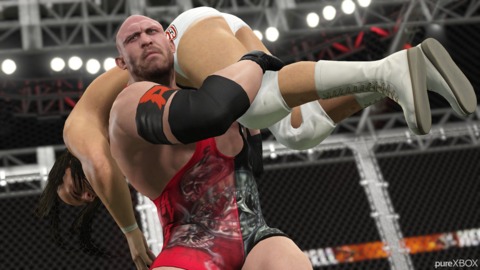
One of the common threads among all these games is that they use some sort of grapple system to perform most of the actual wrestling moves. To varying degrees, these grapple systems also suffer the aforementioned problem of a lack of tactility; you’re pressing a couple buttons and just watching animations take place. With this notion lingering in my mind, I recently played through Skate 3 and came up with a weird idea: The things EA’s Skate did for the skateboarding genre could also be applied to the wrestling genre. That same analog-heavy, limb-based control scheme could be used in a grapple system to make players feel like they’re actually performing moves. I imagine a system where you would press both triggers to lock up with your opponent, then you would move and rotate both analog sticks in specific ways to lift and then slam your opponent. Intricate movement of the sticks could lead to strange and complex moves like this.
As I’m typing these ideas, I realize this control scheme is not even the slightest bit intuitive. This is where the idea of designing a more tactile and complex wrestling game gets tricky: it still has to be intuitive. It has to be playable to a wide audience. Especially if we’re talking about WWE, the casual Raw viewer probably doesn’t care about the mechanical nuances of the in-ring action. They probably just want to play as Brock Lesnar and deliver a billion more german suplexes to John Cena, and they want to do so with as little bullshit as possible.
I’ve rambled on long enough, so I want to hear your ideas, fellow marks. What can wrestling games do to innovate on the conventions of the genre while still remaining simple and fun? Or should we just give up on this pursuit and try breaking kayfabe?
Log in to comment